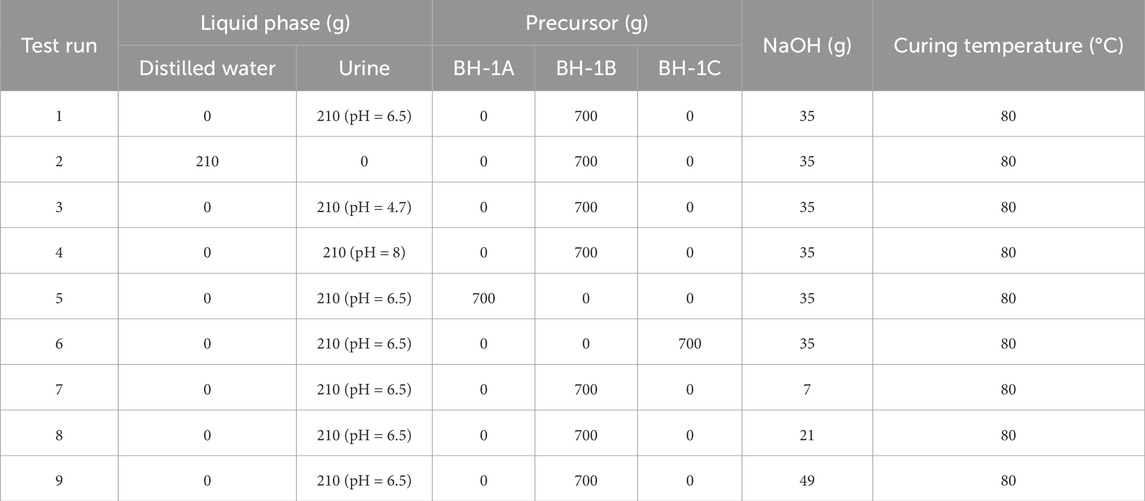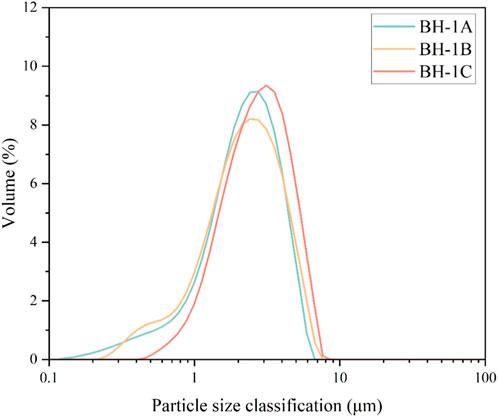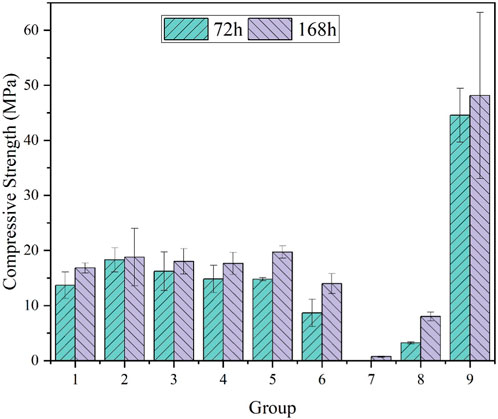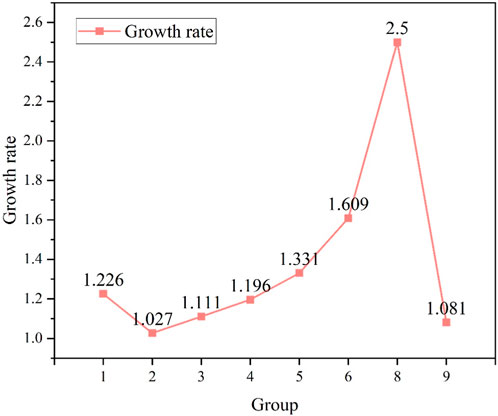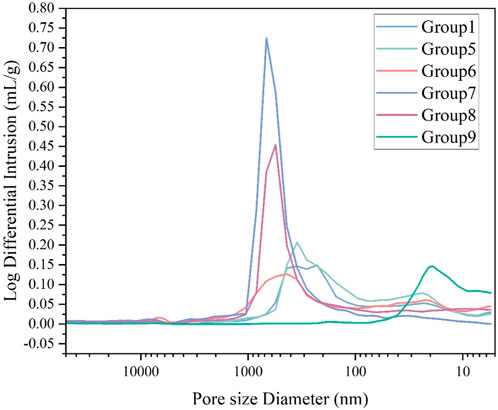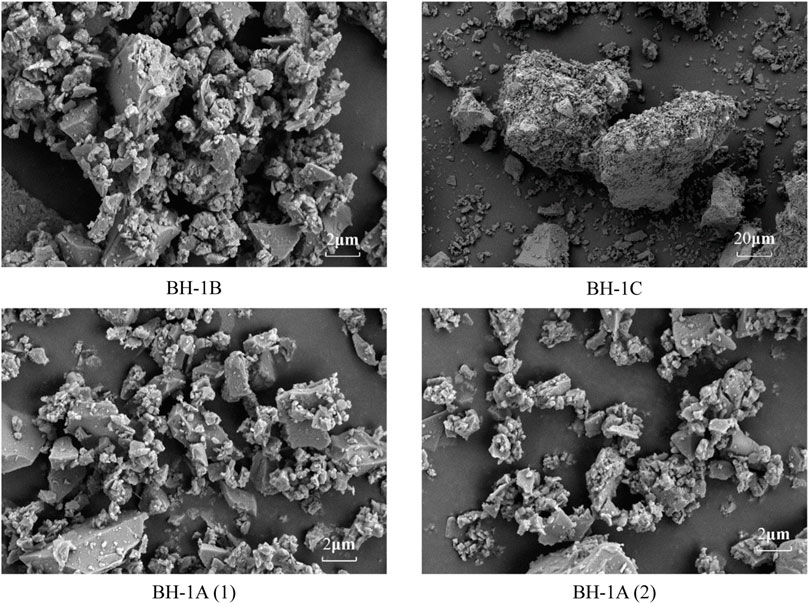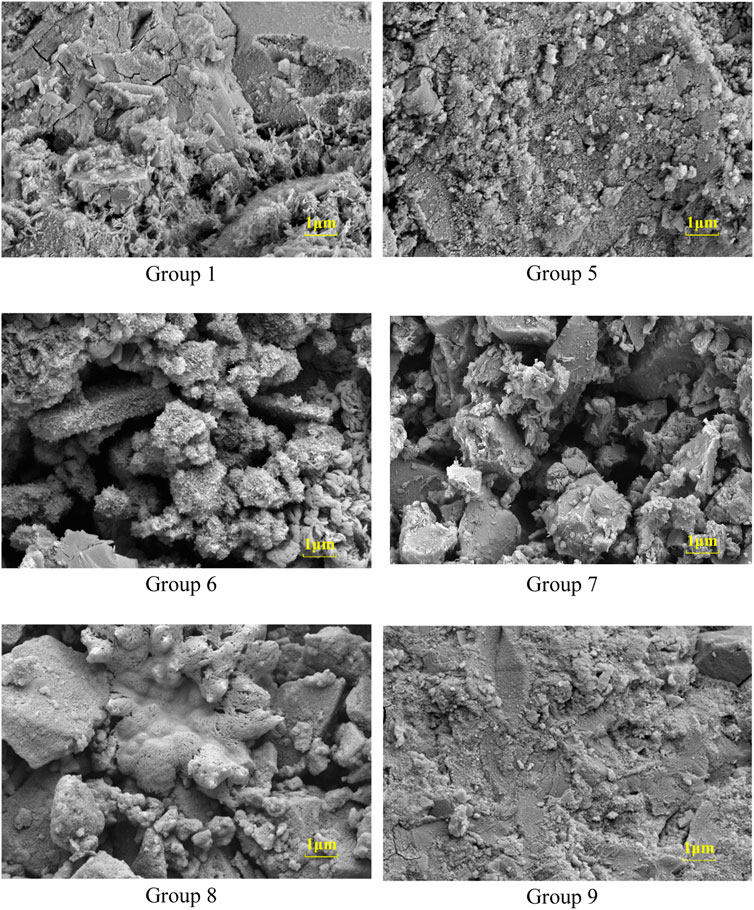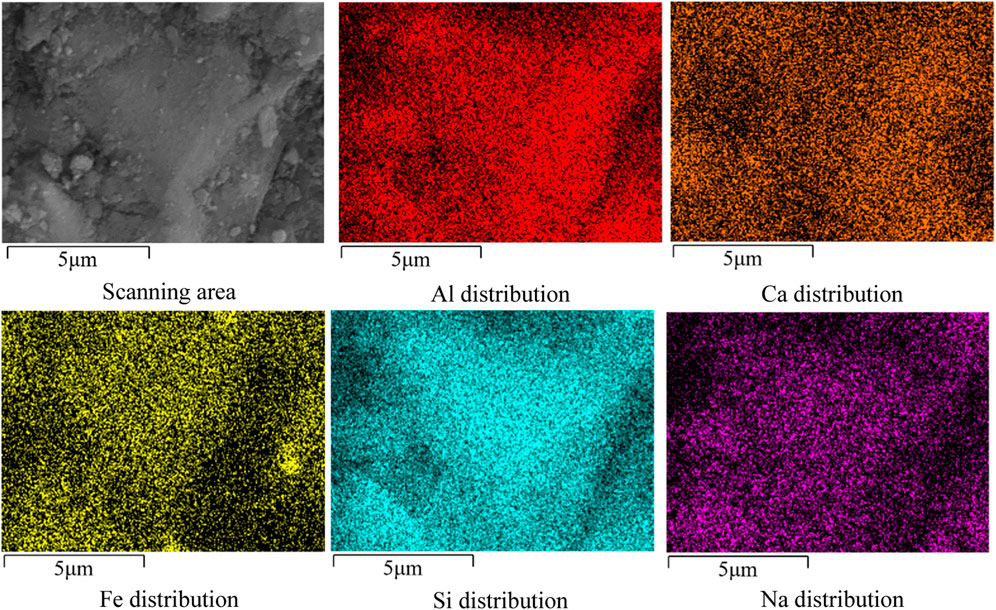Preparation of geopolymer for in-situ pavement construction on the moon utilizing minimal additives and human urine in lunar regolith simulant
- 1School of Civil Engineering, Beijing Jiaotong University, Beijing, China
- 2School of Transportation Science and Engineering, Beihang University, Beijing, China
Constructing lunar pavements is of great significance for improving the transportation efficiency of materials and personnel transfer at lunar bases. Utilizing lunar regolith for the in-situ preparation of geopolymer is an effective means of supplying raw materials for lunar pavement construction. This present study prepared geopolymers for pavement material with lunar regolith simulant. The influence of NaOH on the compressive strength of geopolymers was understood by using different percentages of NaOH as alkaline activator. The effect of urine on the compressive strength of geopolymers by using artificial urine of different pH values as liquid phases. The results indicated that the addition of artificial urine slightly reduces the compressive strength of geopolymers, and the effects of pH and NaOH percentage are different. Microstructural analysis performed by Mercury Intrusion Porosimetry and Scanning Electron Microscope, indicated that choosing fine-particle lunar regolith simulant as precursor is more conducive to the preparation of high-strength geopolymers using human urine.
1 Introduction
The moon is the closest celestial body to Earth with unique space position, making it the key transit station for deep space exploration. The ultimate goal of lunar exploration is to build an extraterrestrial center on the moon for scientific research, production, and other space activities (Lim et al., 2017). A great number of countries have been competing in exploring the moon for years. The International Lunar Research Station Partner Guidelines released by the National Space Administration of China proposed in 2021 that China planned to carry out the construction of an international lunar research station. In 2022, the National Aeronautics and Space Administration (NASA) of the United States also released a draft concerning the strategy of Moon to Mars, planning to validate autonomous building technology on the moon.
Lunar surface pavements are one of the key infrastructures for improving the transportation efficiency of lunar scientific research stations. The lunar surface is rugged and the terrain complex, posing significant difficulties for the movement of lunar rovers, including a high risk of slipping, sinking, or overturning. Additionally, the lunar regolith particles are extremely fine and loose, which can easily generate dust under the action of rover tires. This not only obstructs the astronauts’ view but also adheres to critical components of the rover, such as solar panels, potentially causing damage and failure. Constructing pavements on the lunar surface with adequate structural strength can effectively increase the speed and safety of lunar transportation equipment, further enhance the speed of material transportation and personnel transfer at lunar bases, and thereby significantly improve the efficiency of lunar production, construction, and scientific research activities.
The utilization of in-situ lunar resources is an essential guarantee for the construction of lunar space bases (Ferrone et al., 2022). According to a report released by NASA in 2016, the cost of sending one pound of material into the lunar orbit can reach up to $10000. The entire surface of the moon is covered with a layer of lunar regolith, which can be used locally to produce building materials, thus reducing the weight of materials required to carry on the spacecraft from Earth. In-situ resource utilization can significantly reduce the cost of a lunar space base and risk of missions, making lunar exploration sustainable and affordable (Sanders and Larson, 2013).
The in-situ solidification of lunar regolith is the key issue in the construction of space bases and the in-situ utilization of resources, that is, how to shape loose granular lunar regolith into block or plate shaped objects with certain geometric shapes and mechanical strength. Researchers around the world have adopted different technological routes to develop building materials for lunar space bases using lunar regolith or its simulant, including sintering and melting methods (Fateri and Gebhardt, 2015; Farries et al., 2021), using sulfur in lunar regolith to produce sulfur concrete (Toutanji et al., 2012), and geopolymerization reactions (Lemougna et al., 2018). Sintering and melting methods involve heating lunar regolith using lasers, discharge plasma, microwaves, and other techniques to achieve melting, followed by controlled cooling to solidify it into a desired shape. While the sintering and melting method necessitates no supplementary materials apart from the sintering equipment, it is not devoid of shortcomings: First, it has a high requirement for the particle size of lunar regolith that it requires lunar regolith in micrometer level fineness; Second, it has high energy consumption and high-power demand; Finally, the sintering equipment is complex, heavy, and sometimes unportable, making it difficult to carry it to the moon as a scientific payload. The technical route of sulfur concrete in lunar regolith is also difficult to apply in-situ construction on the lunar surface, due to the fact that sulfur concrete has a melting point of 112°C, poor high-temperature resistance, and there is a risk of melting when the highest temperature on the lunar surface reaches 127°C. Moreover, the technology for extracting sulfur from lunar regolith is not yet mature.
Using lunar regolith as a raw material for geopolymerization reaction is currently a feasible technical route for solidification and molding (Collins et al., 2022). Geopolymer, also known as mineral polymer, is a kind of three-dimensional network polymerization gel of silica tetrahedron and alumina tetrahedron, which is made from natural minerals, solid wastes or artificial silicon aluminum compounds. In recent years, geopolymers have received increasing attention due to their excellent physical, structural, and thermal properties, including researchers in the construction of lunar space bases. Studies indicate that the real lunar regolith samples collected and returned from China’s Chang’e−5 mission are mainly composed of metallic oxides such as SiO2 and Al2O3 (Li et al., 2022). Therefore, using lunar regolith as a silicon aluminum precursor to prepare geopolymer as in-situ building cementitious materials for lunar surfaces has scientific and application prospects in terms of component substitutability and material availability (Duxson et al., 2007). Water is a must for the geopolymerization reaction as the intermediate reactants. However, the current level of technology does not yet support the stable extraction of useable liquid water from lunar regolith. Hence, the exploration for water resources on the Moon stands as pivotal to terrestrial accretion reactions. The waste generated by astronauts comprises fluids and urine, presenting a viable option as a constituent in geopolymerization processes. However, the logistical challenge of managing biological waste on the moon is considerable and economically unfeasible. The absence of gravity and other essential conditions in outer space complicates the treatment of fluid waste, rendering it both laborious and costly. The emphasis of pavement is on resource-rich, cost-efficient, green, and highly thermally stable products (Jiang et al., 2024). Hence, if urine can be purified and take into the use of the construction, it will be environmental-friendly and economical. The work of Pilehvar et al. (Pilehvar et al., 2020) proved that urea can be taken as a chemical admixture for lunar geopolymers of stable compressive strength. Urine contains urea and the components of it is similar to those of urea solution, so urine has the possibility to participate in the chemical reactions of geopolymers.
This study investigates the potential use of artificial urine at different pH levels as a solvent for alkaline activators, aiming to explore the impact of substituting distilled water with urine on the compressive strength of lunar regolith simulant geopolymers. The research seeks to ascertain the feasibility of utilizing astronaut urine waste in lunar construction. Additionally, the influence of sodium hydroxide dosage and particle size distribution of lunar regolith simulant on the properties of urine-containing geopolymers is examined, with the goal of enhancing the in-situ utilization efficiency of lunar regolith while ensuring the mechanical performance of geopolymers.
2 Materials and methods
2.1 Materials
The lunar regolith simulants have a similar composition to that of the real lunar regolith, which can be used as a substitute of the real lunar regolith. In this work, the lunar regolith simulants are volcanic ash extracted from the same volcanic scoria cone from which BH-1 originates (Zhou et al., 2021). BH-1 is a mineralogical and chemical analog to the Apollo 16 real lunar regolith (Zhou et al., 2022) in an acceptable range. The chemical composition of BH-1 and Apollo 16 lunar regolith are shown in Table 1.
From Table 1, it can be concluded that the primary items in the precursors are similar in the content. The chemical composition of the volcanic ash helps the geopolymerization reaction. The oxides such as SiO2, Al2O3, CaO, MgO in volcanic ash can form salt minerals in geopolymerization reactions, promoting the progress, increasing the strength and durability of geopolymers, and enabling them to be applied in practical construction. When reacting with lunar soil minerals, alkaline activators disintegrate the silicon-oxygen and aluminum-oxygen bonds within the minerals, releasing active silicon and aluminum components. These active components then reassemble to form silicoaluminate cement minerals, enhancing the compressive strength of geopolymer.
Raw materials and processing conditions of the precursors are critical in determining the hardening behavior, workability and chemical and physical properties of geopolymeric products. In this paper, the particle size of the precursor is chosen as the comparative factor. The volcanic scoriae were pulverized in the ball mill for 30 min to turn it into volcanic ash. The volcanic ash was screened in both 200-mesh sieve and 600-mesh sieve. The group of the finest particle size who had passed the 600-mesh sieve was named BH-1A. The group of the medium particle size who had been screened through 200-mesh sieve and had not passed 600-mesh sieve was named BH-1B. The group of the coarsest particle size who had not passed 200-mesh sieve was named BH-1C.
The artificial urine solution in the work was to simulate the same condition of human urine. The artificial urine used in this work had a purity above 99%, which was suitable to accomplish the experiments. The artificial urine at pH 6.5 was often used to simulate the actual human urine and, in this work, series of artificial urine at different pH values were used to simulate different acid-base environments on the moon. Real human urine has lots of components. The multi-platform metabolomic analysis can identify 445 and quantify 378 unique urine metabolites or metabolite species (Bouatra et al., 2013). The active ingredients of artificial urine include Na3Citrate, Na2Oxilate, NaCl, Na2SO4, KH2PO4, KCl, NH4Cl, urea and creatinine. Under the condition of maintaining other parameters consistent, distilled water was employed as the solvent in the control group.
The alkaline activator was commercially available sodium hydroxide (NaOH) with a purity above 99% and was utilizable in the experiment. Ryu et al. found that chemical changes of the alkaline activators had a significant effect on the early strength with higher molarity of geopolymers (Ryu et al., 2013). In this work, the sodium hydroxide solutions of different density were used to check out the role of sodium hydroxide played in maintaining the compressive strength of the geopolymer cubes.
2.2 Preparation and proportions for geopolymers
The artificial urine used in this work were at pH 4.7, pH 6.5 and pH 8.0. The pH values could reflect how acid and base affect the compressive strengths of geopolymers, which can tell the influence of the lunar environment on the constructions. The sodium hydroxide solutions were prepared with sodium hydroxide (NaOH) and artificial urine.
To run the experiment, nine groups of geopolymers were prepared to check out the influence of different factors, the proportion of each group were shown in Table 2. Each group got three molds to form three cubes for the experiment.
The material values of each group such as 700 g of precursors were sufficient for making enough geopolymer specimens to run the tests and would not create too much wastes. NaOH in each group weighs 35 g, which is 5% of the weight of precursors. 5% is a minimal value for geopolymer preparation and it greatly improved the in-situ utilization rate of the simulants.
The pH value range of lunar regolith is usually between 5.5 and 8.0. The low pH value of lunar regolith affects the degree of crosslinking and crystallinity of geopolymers, which has a negative impact on the stability of geopolymers and leads to a decrease in the workability. In this experiment, the addition of alkaline activators improved the pH environment and adjusted the pH of lunar regolith simulants and artificial urine, hence enhancing the workability of geopolymers.
After mixing up the materials, the pastes were molded into 40 mm × 40 mm x 40 mm silicone molds. A scraper was used to flatten the surface of the pastes in the molds. Then the molds were vibrated on the vibration table for 1 min to remove bubbles inside the pastes. Then, plastic films were used to envelop the molds to maintain the moisture in the paste so that the loss of the liquid phase would be minimized.
Temperature set at 80°C and humidity controlled at 80%, the curing box provided a reasonable environment for the geopolymer pastes to form the specimens. The geopolymer pastes were first cured in silicone molds in the curing box for 6 h to finalize the shape and consolidate the specimens. Then, the specimens were demolded and sent back to the curing box for the rest of 72 h and 168 h. When the curing time was over, the plastic films were drawn away and the specimens were obtained. Tests were conducted on the specimens after cooling.
2.3 Laboratory tests
Compressive strength is widely used as a key mechanical parameter to evaluate the quality of pavement construction (Jiang et al., 2023). High compressive strength geopolymer can improve road quality and reliability, enhance road bearing capacity, reduce maintenance costs, and promote environmental protection construction. Hence, using high-strength geopolymer to construct high-strength pavement on the lunar surface can provide reliable transportation infrastructure for base construction. The contrast test of nine groups were performed in the testing machine of compressive strength. The testing machine was the Model TYE-3000 compression testing machine produced by Jianyi Instrument Machinery Co., Ltd., China. In the test, geopolymer cubes of each group cured for 72 h and 168 h were tested three times and the data had been recorded.
Mercury intrusion porosimetry (MIP) is a commonly used method for analyzing the pore structure of geopolymers. Mercury intrusion testing can be used to analyze the distribution of pores in geopolymers (Kong et al., 2007). By wetting the geopolymers under a series of different pressures, the range of pore size can be determined and information about pore distribution can be obtained. Mercury intrusion testing can help to the understanding of the impact of geopolymer pore structure on its mechanical properties, water transport, permeability, and other aspects, which deserves guiding significance for optimizing the performance of geopolymer formulations and designs in different engineering applications.
Scanning electron microscope (SEM) technology was used in this work on the geopolymer fragments. SEM can provide high-resolution images of geopolymer, allowing the observation on the microstructure inside the geopolymer. This was helpful for understanding the distribution of various components in geopolymer, the relationship between particles, possible defects and damages, the distribution of cement particles, the shape and structure of cement gel, etc. In addition, the pore structure in geopolymer had a significant impact on its performance. SEM could reveal the shape, size, and distribution of pores in geopolymer, and understand the properties of geopolymer such as permeability, water absorption, and air tightness. SEM could be used to observe the aggregates in geopolymer, understand their morphology, structure, and bonding with the cement matrix. Energy Dispersive Spectrometer (EDS) can provide information on the distribution and content of various elements in geopolymer samples, determining the chemical composition, elemental composition, and elemental differences of geopolymers in different regions. Through elemental analysis, it is possible to understand the main and trace elements present in the sample, hence gaining a deeper understanding of the compositional characteristics of geopolymers.
3 Results and discussion
3.1 Particle size and distribution of lunar regolith simulants
In this paper, the particle size and distribution were tested by laser particle size analyzer. Figure 1 shows the particle size classification of BH-1A, BH-1B and BH-1C.
Figure 1 indicates that the three kinds of precursors have different particle size classifications. The leftmost horizontal coordinates of the curves show the smallest size of the particles of the group. BH-1A has the finest particles, BH-1B has the medium particles and BH-1C has the coarsest particles. The peak of the curve of BH-1C also has a bigger horizontal coordinate which means its most particle distribution is focused on a range of bigger particles. Particles of BH-1B are not so concentrative as those of BH-1A due to its more uniform gradation. The smallest particle size of BH-1A is close to 0.1 μm, but that of BH-1B only approaches 0.2 μm, while that of BH-1C reaches 0.4 μm. The result of the laser particle size analyzer clearly shows the particle size distinction of the three kinds of precursors and thus supporting the work below.
3.2 Compressive strength results
The results of the compressive strength tests of the nine groups under 72 h (3 days) and 168 h (7 days) of curing are shown in Figure 2. Each group have been tested for 3 times and examined on the reliability of the statistics to confirm the data having little contingency.
As for Group 1 to 4, each group uses a different type of artificial urine or distilled water. Urine whose pH = 6.5 used in Group 1, urine whose pH = 4.7 used in Group 3 and urine whose pH = 8.0 used in Group 4 together show the effect pH values made in the experiment, while Group 2 playing as a contrast group who only uses distilled water acting as the liquid phase.
The data shows that the geopolymer cubes in Group 2 have higher compressive strengths, which means that the pH value of Group 2 really caters to the actual need of the geopolymer construction. Applying 5% density of NaOH as the alkaline activator do improve the compressive strengths of the geopolymer cubes and the average strengths Group 2 held (18.33 MPa and 18.8 MPa) are the highest ones in the four group averages. pH value of Group 1 (pH = 6.5) is the most similar one to that of human urine, however, the average compressive strengths of Group 1 are the lowest ones which show that blending ordinary human urine with the precursor will decrease the strength of geopolymers and expand the safety hazards of actual engineering. Geopolymer cubes in Group 3 (pH = 4.7) who are mixed up with urine of lower pH and precursors have higher average compressive strengths, which prove that acid-like urine ingredients approximately make the geopolymer stronger and this pH value is the best one of the three for high-strength-geopolymer creation. The compressive strengths of Group 4 (pH = 8.0) are the medium ones, which concludes that a base-like environment does not always improve the compressive strength as expected. The effect of pH value of urine on the compressive strength has its limitation. The error bar of Group 2 is a little longer than those of the other groups. It can be concluded that the dispersion and uncertainty of Group 2 is bigger and variations between samples are significant.
The ratio of the compressive strengths under 72 h and 168 h of curing can be considered as the growth rate of the geopolymer strength. The growth rate of the eight groups (except Group 7) are shown in Figure 3. Figure 3 shows that the growth rate of Group 2 (1.026) is the lowest, which tells the fact that geopolymer with a distilled-water liquid phase can rapidly form the shape and improve the compressive strength during the curing period. The compressive strength growth rates of the urine groups are higher than that of the distilled water group, confirming that the compressive strengths increased during the curing period, while Group 1 receiving the highest growth rate.
Group 1, 5, and 6 use precursors with different grain size to run the test. According to the statistics of Group 1, 5, and 6, geopolymers of the three groups apply precursors of different grain sizes to contrast. Comparing the three groups of average compressive strengths, geopolymers of Group 6 mixed up with coarse particles of BH-1C have lower strengths and the ones of Group 5 mixed up with fine particles of BH-1A have higher strength in the contrast. It can be seen that the growth rate of Group 6 is the highest of the three groups which suggests that geopolymer prepared from coarse-particle precursors are more likely to grow its strength under curing. The results conclude that grain size of the precursors will affect the compressive strengths and fine-particle precursors will help the geopolymers grow strength faster in the curing box. Fine-particle precursors can also boost the upper limit of the compressive strength.
The test shows that in real lunar construction of geopolymers, precursors of fine particles are more advised to build up lunar structures. The compressive strengths of them have a higher upper limit than precursors of coarse particles under the same time of curing. The growth of their strengths is faster, which guarantees less time in attaining the same safety strength and can be utilized in lunar construction so that the geopolymers will get into use rapidly after preparation.
Group 7, 8 and 9 used 1%, 3%, and 7% NaOH to check out how usage of sodium hydrate affects the compressive strength while Group 1 using 5% NaOH. It is apparent that a high percentage of NaOH will improve the compressive strength of NaOH. Compared with the other groups, the geopolymer strength of Group 9 is hardly variable, due to the lower growth rate of 1.081, thus showing a high percentage of NaOH would rapidly stabilize the strength of the geopolymers. The compressive strength of Group 7 (in Figure 2) was 0 MPa, which meant that the sample was too weak to meet the testing standards of the instrument and its compressive strength could not be detected accurately. The error bar of Group 9 is far longer than those of the other groups. A high percentage of NaOH increased the instability of compressive strength. It also proved that a high percentage of NaOH will improve the compressive strength evidently. Therefore, geopolymers of high strength from low usage of NaOH would be a popular material of lunar construction. The growth rate of Group 8 is much higher than Group 9, showing that geopolymer of low percentage of sodium hydrate would take more time to grow its compressive strength.
After analyzing the three figures of comparison and all the data, three conclusions can be drawn. First, using urine of different pH as liquid phase will inconspicuously decrease the compressive strength. The pH of human urine is close to the pH of Group 1, so ordinary-pH human urine is the most adverse liquid to the strength of geopolymers. In order to improve the strength of geopolymers, pH of the urine shall be controlled and adjusted to a better value. Second, the particle size of precursor will have a great impact on the upper limit of the compressive strength and growth speed in the same time of curing. It is suggested to use precursors of finer particles to improve the strength and growth of geopolymer to suit for lunar construction. Finally, the percentage of sodium hydrate influences the strength well, proving that a proper percentage of sodium hydrate is essential for obtaining explicit data and making a clear visualization.
The compressive strengths of the groups using minimal additives are within the range of 10–20. The compressive strength of the surface layer of asphalt concrete on ordinary pavements is generally required to be 30–50 MPa. The gravitational acceleration of the moon is about 1.63 N/kg, approximately 1/6 of that of the Earth. Hence, the compressive strength of this experiment can meet the requirements of lunar pavement construction.
Using minimal additives aims to improve the in-situ utilization rate. It can be known from the above results geopolymers prepared using 5% sodium hydrate is able to suit the need of general construction. The ultimate purpose is to improve the in-situ utilization rate of lunar soil in the construction of lunar pavement. The result of compressive strength supposes that artificial urine can be used to prepare geopolymers with lunar soil, thus proving that the entire process of geopolymer preparation can be completed on the moon using urine from the astronauts. The lunar soil simulant geopolymers in previous studies requires the involvement of water and alkaline additives, which are raw materials from the Earth. Therefore, the in-situ utilization rate of geopolymer preparation only reach 60%–70% (Li et al., 2023). If the urine of astronauts is used to prepare geopolymer, the liquid phase can also be included as an in-situ material, and lunar soil is also an in-situ material. Therefore, as only about 5% of sodium hydrate is brought to the moon from Earth, the in-situ utilization rate could reach 95% as shown in this study.
3.3 Pore size and distribution of resulting geopolymer
In MIP experiments, gas residues or bubbles in the sample can affect the intrusion of mercury, leading to measurement errors in pore structure parameters. The vibration table was used to remove gas residues and bubbles in the preparation process to ensure that the MIP experimental results are reliable. The results of MIP tests of Group 1, 5, 6, 7, 8, and 9 are shown in Table 3.
Average pore diameter shows the average size of pores in the geopolymer. Bulk density reflects the compaction workability and a higher bulk density means that the material has good compaction performance. Porosity shows the scale of pores of the whole volume in the geopolymers.
In the comparison between Group 1, 5 and 6, average pore diameter of Group 5 is the smallest as expected due to finer particles bonding tightly, shrinking the pore size and thus increasing the bulk density. It proves that the particle size of raw materials has a significant impact on the porosity and pore diameter of geopolymers. The smaller the particle size, the denser the gel structure formed in the geopolymer, and the lower the porosity. Smaller particles can fill more voids and reduce the formation of pores and raise up the bulk density. Smaller particle size helps to improve the uniformity of raw materials. More uniform excitation and activation reaction can form more consistent gel structure and improve the compressive strength of geopolymer.
The average pore diameters of Group 7, 8, and 9 differ extremely. Group 9 with a highest percentage of sodium hydrate has the smallest average pore diameter, the highest bulk density and the lowest porosity shows the influence of the function of alkaline activator. The precursor of geopolymerization is usually raw materials containing silicon and aluminum. Alkaline activator can activate the silicon aluminum oxide, promote its hydration and hardening reaction, and lead to the formation of silicon aluminum gel. The formation of gel structure makes geopolymer more compact and firmer, thus enhancing the mechanical properties and improving the compressive strength. Obviously, the participation of alkaline activators in the reaction reduces the pore diameter and porosity in the geopolymer.
The pore size distributions of the 168 h specimens of Group 1, 5, 6, 7, 8, and 9 are shown in Figure 4. Group 1, 5, and 6 use different kinds of precursors to form geopolymers and their pore size distribution are corresponding to the actual size of the particles. The most proportion of the pore diameter is concentrated on the horizontal coordinate of the curve peak, which indicates the pore size of the most pores of the geopolymer. Comparing Group 1, 5, and 6, it can be seen that the most pores of Group 6 are bigger than those of Group 5 and 6. Also, from 100 nm to 10 nm, the curve of Group 5 are higher than that of Group 1, which shows that geopolymer of Group 5 contains more larger pores than that of Group 1. The results proves that the finer the particles of precursor, the thicker and stronger the geopolymers. A proper particle size of precursors would surely enhance the strengths of the geopolymers.
Group 7, 8, 1, and 9 have a different percentage of sodium hydrate of 1%, 3%, 5% and 7% when making geopolymers. The horizontal coordinates of the curve peaks are the pore size diameter of the most particles of the product. As expected, their curve peaks are Group 7, 8, 1, and 9 from left to right, thus proving the use of sodium hydrate can lessen the size of the pores and improve the strengths of the geopolymers.
3.4 SEM-EDS results
SEM-EDS testing are conducted on the groups of precursors and geopolymers. The precursors were dried and preserved in plastic capsules before testing. The geopolymer samples used for SEM-EDS testing were crushed into fragmental samples in the size of soybeans to achieve better experimental results. The treatments improved the accuracy of the testing. The SEM results of the three kinds of precursors are shown in Figure 5.
The particle size of BH-1B is coarser than that of BH-1A and finer than BH-1C. Take BH-1B as the control group, the influence of different particle size on microstructure are presented. In the image of the coarsest group BH-1C, the particles are evidently bigger than the other groups. The particles show irregular morphology of fragments clinging onto the surfaces of the volcanic ash precursor. It can be concluded that after mixing up the materials, the irregular surface of the precursor would create larger pores in the geopolymers and the compressive strengths of them would be weak. The images of BH-1A show that the volcanic ash particles are dispersed and more smooth surfaces can be seen. In the mixing process, the dispersed particles would densely connect with each other and highlights the effect fine-particle precursor exert on the compressive strengths of geopolymers.
The SEM results of geopolymers made with different proportion under 168 h curing are shown in Figure 6. At the same magnification, the section plane of the geopolymers of Group 1, 5, and 6 shows obvious difference. In the image of Group 5, there are tiny particles and fragments tightly integrated and closely clinging onto the surface, and only a few tiny pores can be found in the image. That is because the finer particles filled up the gaps in the mixing process. On the contrary, the image of Group 6 shows greater pores and large gaps between gels, indicating that the structure of the geopolymer is not so tight for the irregular morphology generated from the coarse particles.
The images of Group 7, 8, and 9 reflects the impact of sodium hydrate on the morphology of the section surface. The section surface of Group 7 is more fragmented in morphology and that of Group 9 shows obvious smoother surface. In the comparison of Group 7, 8, and 9, it can be concluded that more sodium hydrate used in the geopolymer, decreasing the pore size and gap in microstructure and improving the tightness between gels, can make the section surface tighter in microstructure. The results of SEM further prove that tight gel structure and less pores contribute to the compressive strength of the geopolymer.
SEM-EDS measures the weight percentage of the elements, showing how the elements binding together to make the structure stronger. Take Group 5 as an example, the element distribution energy spectrums are shown in Figure 7 and the results of SEM-EDS are shown in Table 4.
Si: Al ratio deeply correspond to the strength of geopolymers (Duxson et al., 2005; Wan et al., 2017). Si and Al, as important elements in geopolymerization, have weight percentages of 44.94% and 16.44% with atomic percentages of 49.38% and 18.81%, which suggest that Si and Al, deeply binding together, are in a high polymerization state. Na: Si ratio reflects the sodium content in the geopolymer. Sodium in geopolymers leads to the formation of hydration products, increase the interaction between geopolymers and ions in the environment, lead to the dissolution or swelling of geopolymers, affecting their chemical stability and durability. The weight percentage of Na is 7.11%, which is proper to maintain the compressive strength of the geopolymer. Fe: Si ratio may have an impact on the strength and hardness of geopolymers. The performance of geopolymers is influenced by the molar ratio of Si: Al: Na. However, as the composition of lunar regolith is not fixed, conducting experiments using a single component regolith ratio has limitations. The composition of the lunar regolith is complex and diverse, including silicates, oxides, sulfur compounds, etc. A single component regolith simulant cannot simulate the various components and their interactions while the proportion of elements is influenced by various factors. Hence, the single component regolith simulant could not accurately simulate the complex geological processes and impacts.
SEM-EDS testing can be influenced by multiple factors such as insufficient polishing, surface contamination, leading to errors or uncertainties in the test results. Sandpaper was used to polish the fragmental samples to ensure that the surface was fully polished. Simultaneously operating in a clean laboratory environment and avoiding direct contact with the sample surface as much as possible, reduces the possibility of contamination. The testing sample was in good storage condition.
4 Conclusions and future work
In this paper, the experiment was conducted using the particle sizes of the lunar regolith simulants, the pH values of artificial urine in the liquid phase, and the dosage of alkaline activator as variables to make geopolymers. Based on the analysis on the compressive strength results, porosity and observation of microstructure, the conclusions can be drawn as follows.
• Using urine as the liquid phase slightly reduced the compressive strength of the geopolymers. Adjusting the pH value of the liquid phase is one of the reliable means to improve the compressive strength of the geopolymer. Adding urine to the materials of the experiment did not affect the preparation of the geopolymer and its functions evidently and the geopolymer prepared using urine had the similar workability and mechanical properties as the traditionally-prepared geopolymer.
• Particle sizes of the volcanic ash precursors exert priority on the compressive strength that the strengths of fine-particle geopolymers are higher and the coarse-particle ones are lower. The compressive strength of the coarse-particle group shows evident disparity to the other groups. Via MIP and SEM tests, it can be seen that the porosity of the fine-particle geopolymer is lower and the pores are notably smaller in the image, and coarse-particle geopolymers have more pores and voids on the section surface. The results show that using precursors of finer particles can improve the strength of geopolymers.
• Sodium hydrate, the alkaline activator, can influence the compressive strength of the geopolymer. The higher the percentage of NaOH, the stronger the compressive strength. Higher growth rate of compressive strength in the curing time appeared in the groups containing more sodium additive. The sodium hydrate intensifies the hydration and hardening reaction of the raw materials, tightening up their bonding degree. Minimal additives can be used to prepare geopolymers of sufficient strength.
This work provides a possible basis for the preparation of geopolymer using human urine as a part of the materials in space and lunar construction, which use up biological waste and guarantee the strength requirement of practicality. It also proves the particle size and NaOH percentage have impacts on the compressive strength of the geopolymer while influencing the microstructure like pore size distribution and gel structures. Fine size particles are more advised for the preparation of high-strength geopolymers. Recommended raw materials to prepare geopolymers in this paper can include 5% alkaline activator, fine-particle precursors and 30% urine solution of higher pH.
Geopolymer preparation with urine are also faced by challenges on the moon. The actual construction of lunar pavement has a huge demand of liquid in the geopolymerization. However, the amount of urine available on the moon is limited, as the urine can only be extracted from biological waste. So huge as the construction of a lunar pavement is, it seems impossible to rely on human urine alone. Other liquid phases such as purified waste water should also be taken into account. Fundamentally speaking, the water carried by spacecraft remains the main source of water for the preparation of geopolymers. The current research proves that improvement on the in-situ utilization rate of lunar regolith with urine can be realize, but the source of liquid phases in actual construction should be diverse.
The high vacuum and low gravity environment on the lunar surface raise higher requirements for equipment for preparing geopolymers due to that the liquid phase easily evaporates in a vacuum environment. The lunar environment demands more complex and precise instruments and the exploration to the moon is also developing its techniques.
Data availability statement
The original contributions presented in the study are included in the article/supplementary material, further inquiries can be directed to the corresponding author.
Author contributions
LC: Data curation, Methodology, Writing–original draft. TW: Supervision, Writing–review and editing. FL: Conceptualization, Funding acquisition, Project administration, Supervision, Writing–review and editing. SZ: Visualization, Writing–original draft, Writing–review and editing.
Funding
The author(s) declare that financial support was received for the research, authorship, and/or publication of this article. This research was supported by China Postdoctoral Science Foundation (No. 2023M730174), Young Elite Scientists Sponsorship Program by CAST (No. YESS20230576), Frontier cross Fund Project of Beihang University (B22071).
Conflict of interest
The authors declare that the research was conducted in the absence of any commercial or financial relationships that could be construed as a potential conflict of interest.
Publisher’s note
All claims expressed in this article are solely those of the authors and do not necessarily represent those of their affiliated organizations, or those of the publisher, the editors and the reviewers. Any product that may be evaluated in this article, or claim that may be made by its manufacturer, is not guaranteed or endorsed by the publisher.
References
Bouatra, S., Aziat, F., Mandal, R., Guo, A. C., Wilson, M. R., Knox, C., et al. (2013). The human urine metabolome. PloS one 8 (9), e73076. doi:10.1371/journal.pone.0073076
Collins, P. J., Edmunson, J., Fiske, M., and Radlińska, A. (2022). Materials characterization of various lunar regolith simulants for use in geopolymer lunar concrete. Adv. Space Res. 69 (11), 3941–3951. doi:10.1016/j.asr.2022.03.012
Duxson, P., Fernández-Jiménez, A., Provis, J. L., Lukey, G. C., Palomo, A., and van Deventer, J. S. (2007). Geopolymer technology: the current state of the art. J. Mater. Sci. 42, 2917–2933. doi:10.1007/s10853-006-0637-z
Duxson, P., Provis, J. L., Lukey, G. C., Mallicoat, S. W., Kriven, W. M., and Van Deventer, J. S. (2005). Understanding the relationship between geopolymer composition, microstructure and mechanical properties. Colloids Surfaces A Physicochem. Eng. Aspects 269 (1-3), 47–58. doi:10.1016/j.colsurfa.2005.06.060
Farries, K. W., Visintin, P., Smith, S. T., and van Eyk, P. (2021). Sintered or melted regolith for lunar construction: state-of-the-art review and future research directions. Constr. Build. Mater. 296, 123627. doi:10.1016/j.conbuildmat.2021.123627
Fateri, M., and Gebhardt, A. (2015). Process parameters development of selective laser melting of lunar regolith for on-site manufacturing applications. Int. J. Appl. Ceram. Technol. 12 (1), 46–52. doi:10.1111/ijac.12326
Ferrone, K. L., Taylor, A. B., and Helvajian, H. (2022). In situ resource utilization of structural material from planetary regolith. Adv. Space Res. 69 (5), 2268–2282. doi:10.1016/j.asr.2021.12.025
Jiang, X., Zhu, H., Yan, Z., Zhang, F., Huang, X., Leng, Z., et al. (2024). Fire-retarding asphalt pavement for urban road tunnels: a state-of-the-art review and beyond. Fire Technol., 1–41. doi:10.1007/s10694-024-01556-2
Jiang, X., Zhu, H., Yan, Z., Zhang, F., Ye, F., Li, P., et al. (2023). A state-of-art review on development and progress of backfill grouting materials for shield tunneling. Dev. Built Environ. 16, 100250. doi:10.1016/j.dibe.2023.100250
Kong, D. L., Sanjayan, J. G., and Sagoe-Crentsil, K. (2007). Comparative performance of geopolymers made with metakaolin and fly ash after exposure to elevated temperatures. Cem. Concr. Res. 37 (12), 1583–1589. doi:10.1016/j.cemconres.2007.08.021
Lemougna, P. N., Wang, K. T., Tang, Q., Nzeukou, A. N., Billong, N., Melo, U. C., et al. (2018). Review on the use of volcanic ashes for engineering applications. Resour. Conservation Recycl. 137, 177–190. doi:10.1016/j.resconrec.2018.05.031
Li, C. L., Hu, H., Yang, M. F., Pei, Z. Y., Zhou, Q., Ren, X., et al. (2022). Characteristics of the lunar samples returned by the Chang'E-5 mission. Natl. Sci. Rev. 9 (2), nwab188. doi:10.1093/nsr/nwab188
Li, F., Zhang, R., Zhou, S., and Zhu, X. (2023). Printability and hardening performance of three-dimensionally-printed geopolymer based on lunar regolith simulant for automated construction of lunar infrastructure. Front. Struct. Civ. Eng. 17, 1535–1553. doi:10.1007/s11709-023-0003-0
Lim, S., Prabhu, V. L., Anand, M., and Taylor, L. A. (2017). Extra-terrestrial construction processes–Advancements, opportunities and challenges. Adv. Space Res. 60 (7), 1413–1429. doi:10.1016/j.asr.2017.06.038
Pilehvar, S., Arnhof, M., Pamies, R., Valentini, L., and Kjøniksen, A. L. (2020). Utilization of urea as an accessible superplasticizer on the moon for lunar geopolymer mixtures. J. Clean. Prod. 247, 119177. doi:10.1016/j.jclepro.2019.119177
Ryu, G. S., Lee, Y. B., Koh, K. T., and Chung, Y. S. (2013). The mechanical properties of fly ash-based geopolymer concrete with alkaline activators. Constr. Build. Mater. 47, 409–418. doi:10.1016/j.conbuildmat.2013.05.069
Sanders, G. B., and Larson, W. E. (2013). Progress made in lunar in situ resource utilization under NASA’s exploration technology and development program. J. Aerosp. Eng. 26 (1), 5–17. doi:10.1061/(asce)as.1943-5525.0000208
Toutanji, H. A., Evans, S., and Grugel, R. N. (2012). Performance of lunar sulfur concrete in lunar environments. Constr. Build. Mater. 29, 444–448. doi:10.1016/j.conbuildmat.2011.10.041
Wan, Q., Rao, F., Song, S., García, R. E., Estrella, R. M., Patino, C. L., et al. (2017). Geopolymerization reaction, microstructure and simulation of metakaolin-based geopolymers at extended Si/Al ratios. Cem. Concr. Compos. 79, 45–52. doi:10.1016/j.cemconcomp.2017.01.014
Zhou, S., Lu, C., Zhu, X., and Li, F. (2021). Preparation and characterization of high-strength geopolymer based on BH-1 lunar soil simulant with low alkali content. Engineering 7 (11), 1631–1645. doi:10.1016/j.eng.2020.10.016
Keywords: lunar pavement, lunar in-situ construction, geopolymer, lunar regolith simulant, human urine
Citation: Chen L, Wang T, Li F and Zhou S (2024) Preparation of geopolymer for in-situ pavement construction on the moon utilizing minimal additives and human urine in lunar regolith simulant. Front. Mater. 11:1413432. doi: 10.3389/fmats.2024.1413432
Received: 07 April 2024; Accepted: 06 May 2024;
Published: 17 May 2024.
Edited by:
Hui Yao, Beijing University of Technology, ChinaReviewed by:
Xi Jiang, Hong Kong Polytechnic University, Hong Kong SAR, ChinaFang Xu, China University of Geosciences, China
Copyright © 2024 Chen, Wang, Li and Zhou. This is an open-access article distributed under the terms of the Creative Commons Attribution License (CC BY). The use, distribution or reproduction in other forums is permitted, provided the original author(s) and the copyright owner(s) are credited and that the original publication in this journal is cited, in accordance with accepted academic practice. No use, distribution or reproduction is permitted which does not comply with these terms.
*Correspondence: Siqi Zhou, zsq47@buaa.edu.cn
 Lichong Chen
Lichong Chen Tao Wang
Tao Wang Feng Li
Feng Li Siqi Zhou
Siqi Zhou
